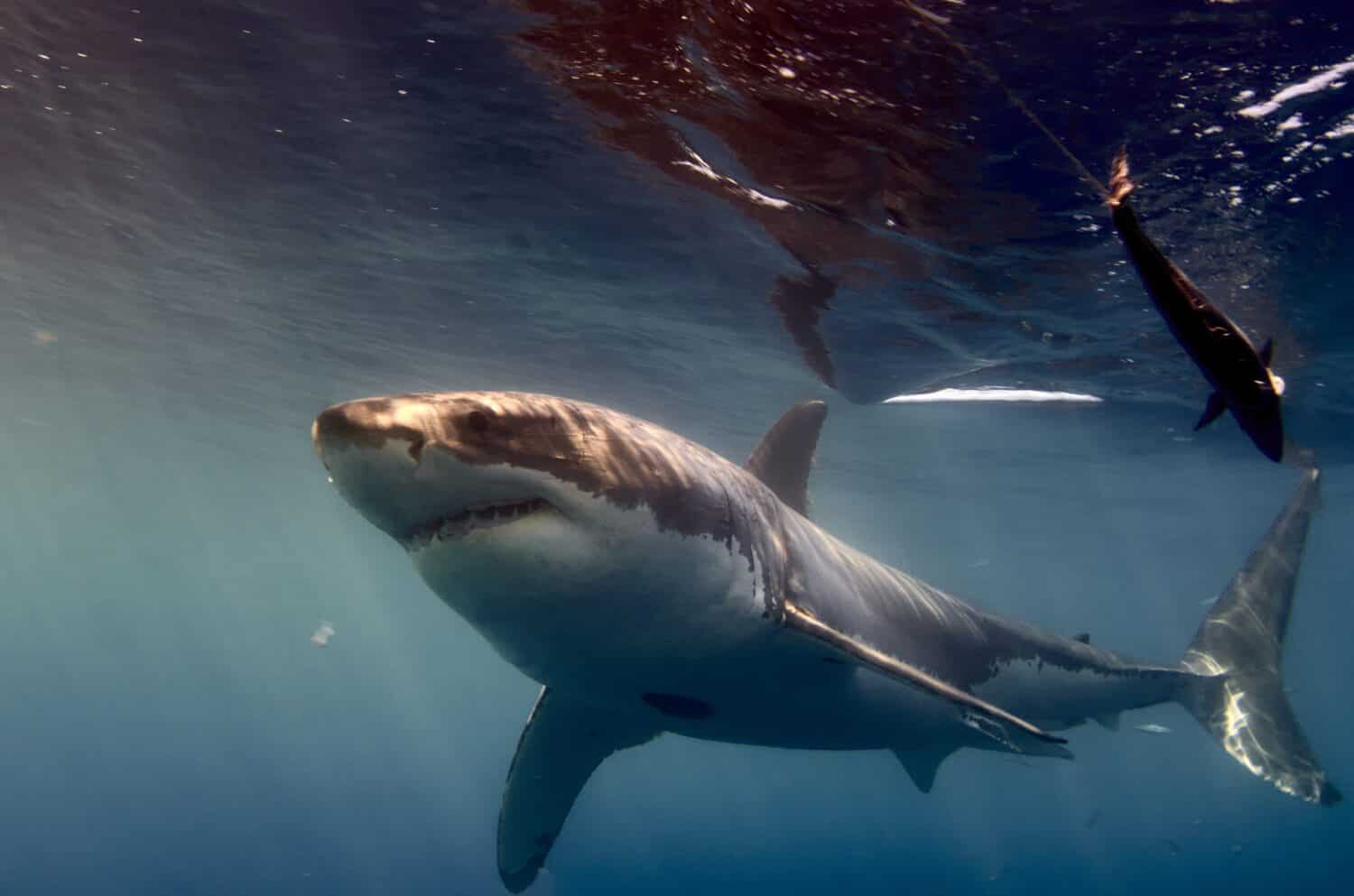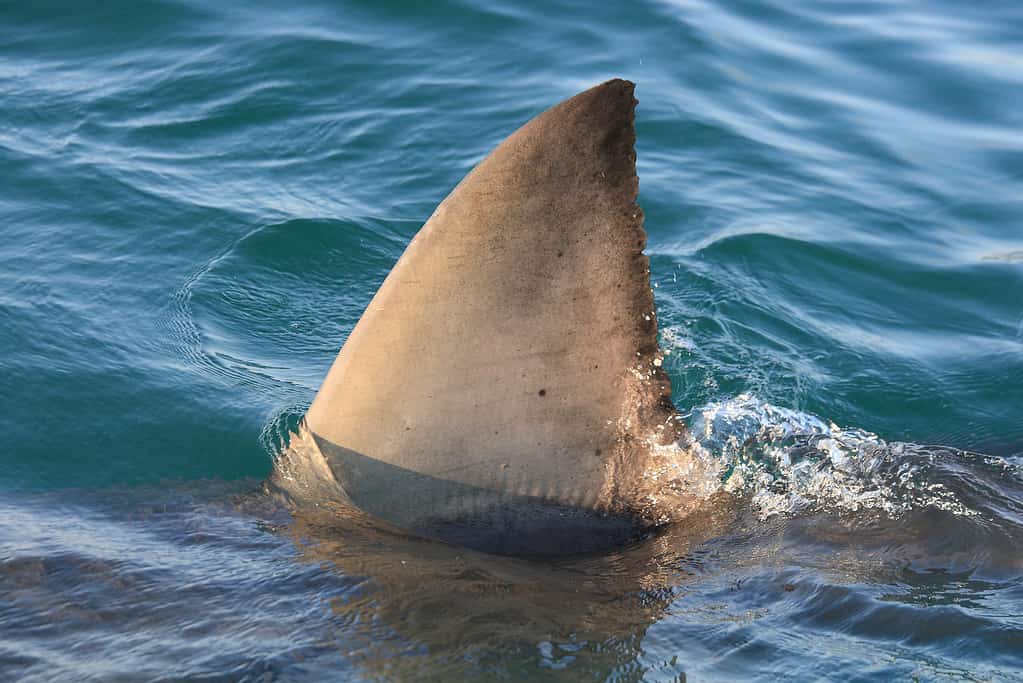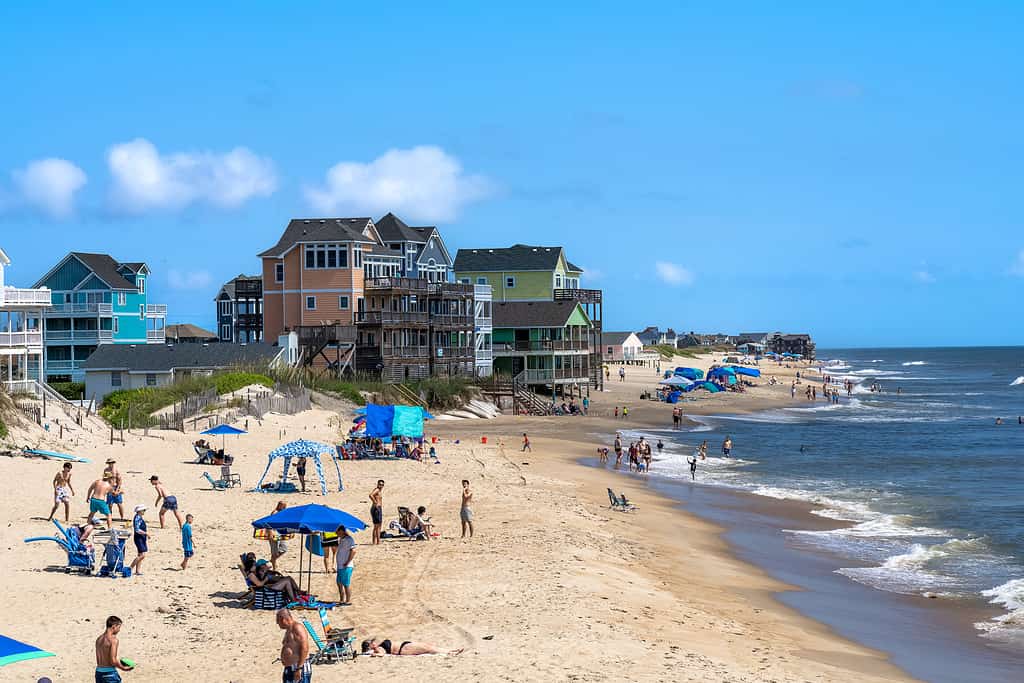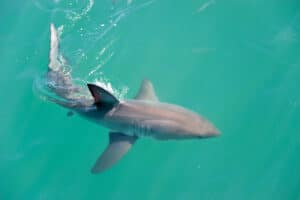The waters of North Carolina’s Outer Banks are currently teeming with great white sharks (Carcharodon carcharias).
OCEARCH, a nonprofit organization dedicated to studying and preserving great white sharks, has tagged 88 of these apex predators throughout the western North Atlantic. Each tag that is affixed to a shark’s dorsal fin is equipped with a transmitter. When the shark’s fin breaks the surface of the water, the transmitter sends a ping which OCEARCH uses to geolocate the shark. Often those pings are spread out over large distances, from the Gulf of Mexico to Quebec and Newfoundland. That is certainly not the case right now. All of the pings over the last two days have been centered in one place: the Outer Banks of North Carolina.

A shiver of great whites has shown up in North Carolina.
©Wirestock Creators/Shutterstock.com
The Sharks
Six tagged sharks have shown themselves in North Carolina waters in less than 48 hours. The pings are a mix of juvenile and adult great whites.
OCEARCH names each shark that it tags. Here are the six sharks that are currently tracking off the North Carolina coast.
Martha
Martha is the smallest of the sharks currently showing up on OCEARCH’s tracker. This juvenile female shark is seven feet long and weighs around 200 pounds. Martha was a mere pup when OCEARCH researchers tagged her on August 13, 2020, in Cape Cod, Massachusetts.
Gladee
OCEARCH researchers tagged Gladee on October 1, 2020, in Lunenburg, Nova Scotia. This shark is a juvenile female weighing around 400 pounds and measuring eight feet long.
Jekyll
Jekyll is a male juvenile great white measuring eight feet long and weighing 400 pounds. OCEAERCH researchers tagged his white shark a few months ago, on December 9, 2022, off of Jekyll Island, Georgia.
Simon
Simon is another juvenile male currently swimming in North Carolina waters. He is a nine-foot-long male great white weighing over 430 pounds. This shark is also new to OCEARCH’s tracking system. Researchers tagged Simon on December 4, 2022, off of St. Simon’s Island, Georgia.
Ormond
Ormond is a sub-adult male great white. This shark measures nine feet long and weighs 640 pounds. OCEARCH has tracked Ormond since researchers tagged him off St. Simon’s Island, Georgia, on November 29, 2022.
Breton
Breton is a massive adult male great white. This shark measures over 13 feet long and weighs 1,500 pounds. Breton is one of the largest sharks in the OCEARCH database. He was tagged on September 12, 2020, off the coast of Scatarie Island, Nova Scotia.
North Carolina
Every one of these sharks, from the small Martha to the giant Breton, is swimming in the same location right now. Each was pinged on March 28 or 29 off the coast of the Outer Banks.
Why are so many great whites congregating in North Carolina at the same time? Thanks to OCEARCH’s research, we may know the answer. Patterns have emerged as these scientists have tracked great whites over the last several years. One pattern that has become abundantly clear is great white sharks gravitate to North Carolina in February and March. There seems to be mounting evidence that these waters are a great white shark nursery.
We have learned much about the life cycle of great white sharks, but their mating habits are still a bit of a mystery. OCEARCH calls great white shark mating “the last piece of the puzzle” in our understanding of these sharks. If a nursery can be definitively found in North Carolina waters, it would answer many questions regarding the sharks’ annual appearance in these same waters.

Is North Carolina a great white shark nursery? It seems likely.
©iStock.com/Alessandro De Maddalena
Staying Safe
If there are this many tagged sharks in North Carolina right now, how many more untagged, untracked sharks are in these waters? No one knows, but the answer would seem to be a lot. A whole lot. How should beach-lovers and spring breakers respond?
Even with this significant upswing in the number of great whites in North Carolina, it’s important to remember that the risk of an actual human/shark encounter is low. There have been no shark attacks reported in North Carolina yet this year, unlike Florida which seems destined to retain its title as the shark attack capital of the world.
Even so, when the waters are teeming with the ocean’s apex predator, some cautionary steps, combined with common sense, are needed. Here are a few things to help you stay safe while at the beach.

How should North Carolina beachgoers respond to this huge influx of great whites?
©iStock.com/Kyle Little
Beachgoers Checklist
- Don’t swim alone. A group of swimmers is far less likely to encounter a shark than a lone swimmer.
- Don’t wear jewelry or shiny swimsuits. When the sun hits these flashy objects, the rays are reflected in the water. To a shark’s eyes, it may look like the sun reflecting off the fins of a fish. Most shark attacks are actually the result of a shark mistaking a human for prey. Sharks have relatively poor eyesight. Don’t wear anything that may give the illusion of a fish or prey animal.
- Stay away from commercial and recreational anglers. Their bait or lures may attract sharks to the area.
- Stay in the shallows. The further you swim from shore, the greater your chances of encountering a shark.
- Check local reports before heading out for a day at the beach. If a beach is reporting increased shark activity, stay out of the water.
- And, you would think this goes without saying but never harass a shark. It has happened before, with dire consequences. Unprovoked shark attacks are tragic. Provoked shark attacks are stupid and completely preventable.
The photo featured at the top of this post is © Elias Levy / CC BY 2.0 – License / Original
Thank you for reading! Have some feedback for us? Contact the AZ Animals editorial team.







